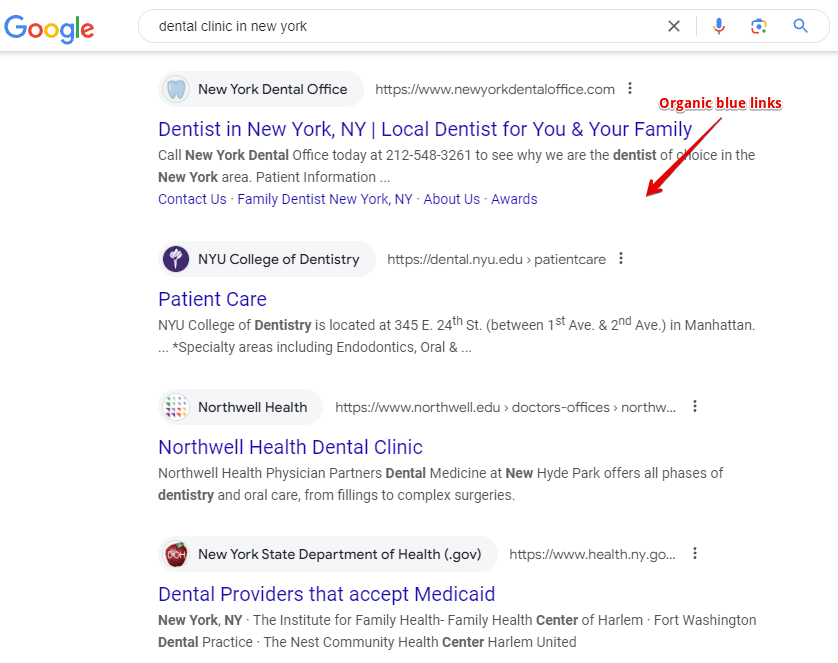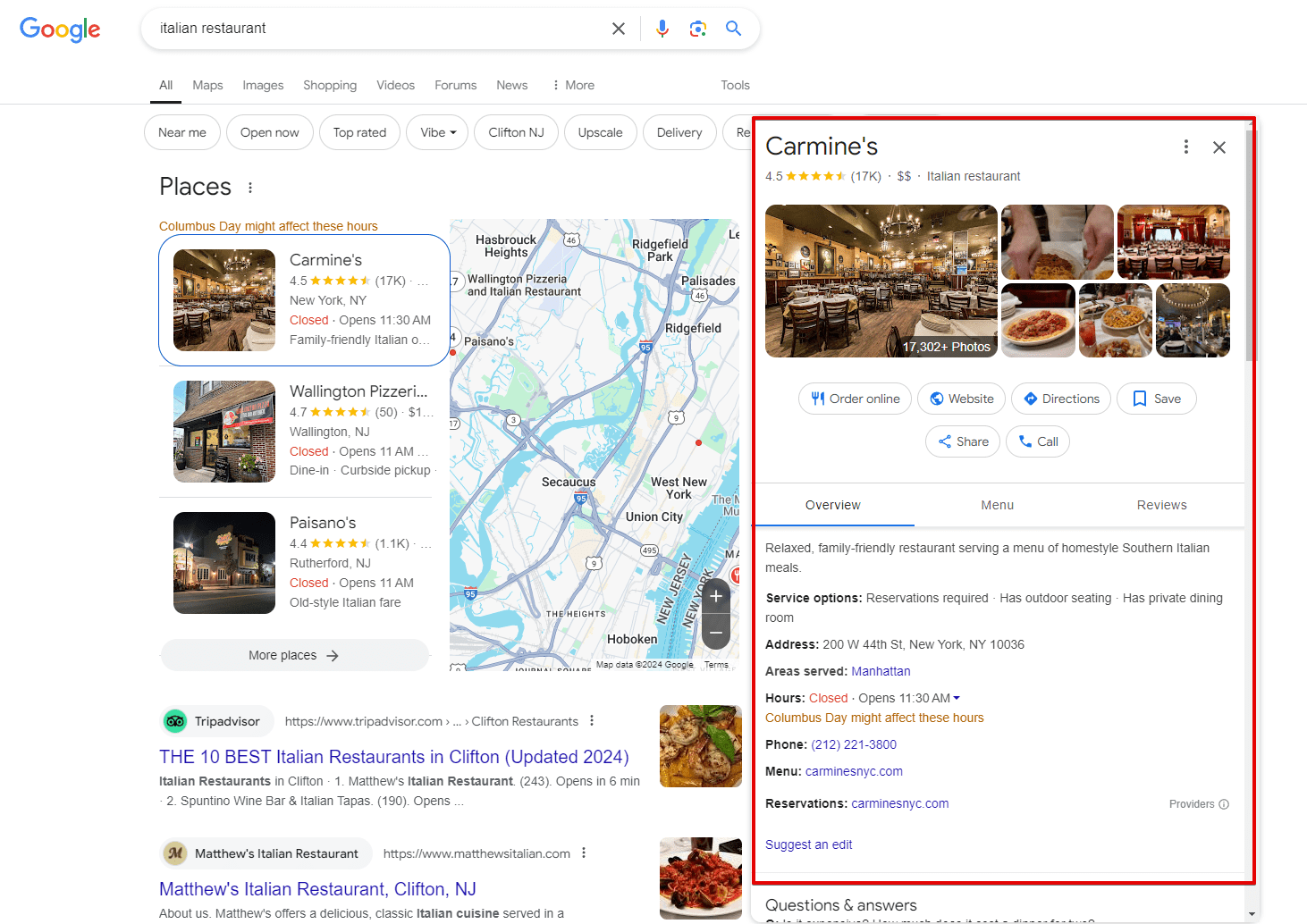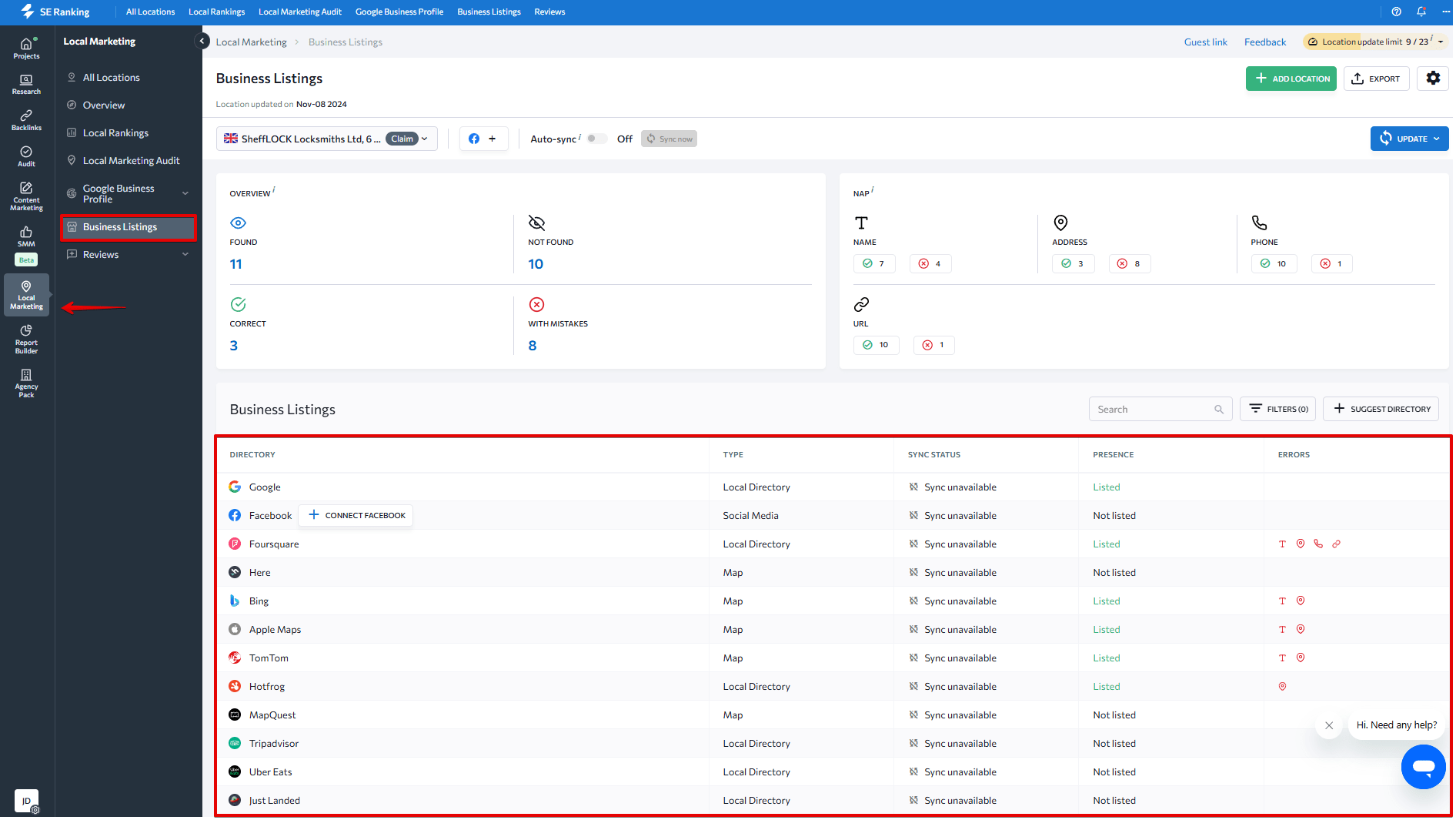Local SEO: A Quick Starter Guide
What is local SEO?
Local Search Engine Optimization (Local SEO) is a digital marketing technique for improving business visibility in local search results, ideally in relevant local searches. Geographic terms, such as city names or “near me” phrases are common in the local search market. Some examples of queries with local intent include “best coffee shop in New York”, and “emergency dentist near me.”
Optimizing locally helps you appear in the Google local pack (aka map pack) search results:

It also improves your visibility in the traditional “blue links” organic search results. These organic links are based on the searcher’s location:

It’s common to find traditional organic search results under the local pack results.
Since local SEO is about reaching people in highly targeted geographic areas, your business will benefit most if it’s a restaurant, dental clinic, retail shop, law firm, or some other in-person service provider.
Why does local SEO matter?
Consumers are always using search engines to find local services, with Google handling billions of local searches each month.
In fact, nearly half of all local searchers click on Google’s Map Pack listings, with 42% choosing businesses featured there. Most people stick to the first page of search results for local queries, making visibility there crucial. If your business isn’t listed on the first page, you could be missing valuable customers.
Having a strong local Google search presence makes it easier for people to quickly find your business and learn about your products or services.
What ranking factors does Google use for local search results?
Although Google uses a complex algorithm to determine local search rankings, it can be dumbed down to three primary factors: relevance, distance, and prominence.
- Relevance. This indicates how well your business matches searcher queries. So it’s crucial to maintain accurate and complete business information, use relevant keywords, and keep your services up-to-date on your Google Business Profile (GBP).
- Distance. Google looks at how far your business is from the searcher’s location or the location term used in the search. Ensure your NAP data is correctly listed across the web.
- Prominence. This indicates how well-known or prominent your business is, both online and offline. Offline prominence, as in museums or landmarks, is reflected in local search results. Online prominence is also important. It includes customer reviews, overall online presence, mentions on reputable sites, and business listings. The more positively you’re talked about online, the better you will rank.
Other key elements can influence your local search rankings, including:
- The sentiment and quantity of your reviews
- Google Maps star ratings
- Your website’s overall SEO health
- Local content (e.g., area-specific pages or blog posts) and its quality
- Website performance (speed and mobile-friendliness)
How to get started with local SEO
Local SEO involves optimizing for both the local pack and traditional organic search results. Some local ranking factors impact both, while others are specific to one or the other.
Let’s start with the basics.
1. Add your company to Google Business Profile
Google Business Profile is a so-called Google’s online catalog of local businesses. It features key information for your potential clients to find and learn about your local business. This information is displayed across Google’s various platforms, including on Google Search and Maps.
Google prioritizes local Google Business Profiles that are optimized well for local search. Updating your profile with accurate and thorough information makes it easier for Google to display your business in local results. See the screenshot example below:

The local 3-pack, which appears as a trio of businesses at the top of local search results, is a coveted spot. Achieving this position means you’ll be more visible to customers who use relevant search terms. This can increase visits, calls, and foot traffic to your website.
To increase your chances of ranking in the local 3-pack, fill out your Google Business Profile completely. Here’s what to cover:
- Business name, address, and phone number (NAP)
- Business category and subcategories
- Website URL
- Business description
- Operating hours
- Products or services offered
- High-quality photos and videos
2. Encourage and respond to online reviews
Positive business reviews boost your local search performance and build trust with potential customers. Snippets from customer reviews may appear directly in your listing within the map pack, providing new potential customers with immediate social proof.
But receiving reviews is only part of the process. Consider taking a more active role, as 88% of consumers prefer businesses that respond to all reviews, whereas only 47% of consumers don’t.
See Google’s best practices for managing reviews below:
- Verify your Business Profile to ensure your information shows on Google services and to respond to reviews.
- Encourage customers to leave reviews by making it easy. Don’t give incentives.
- Respond to reviews to build trust and show you value feedback.
- Acknowledge all reviews. Showing both positive and negative ones enhances credibility.
- Share your review link in thank-you emails, chat interactions, or on receipts.
3. Get listed in local business directories and build citations
To build a positive image and establish trust in your business, list it on well-known online directories like Google, Facebook, Yellowpages, Bing Places, Apple Maps, etc. or other authoritative websites. Create local citations as well.
Local citations are external mentions of your business’s name, address, and phone number (NAP) that validate your business’s legitimacy to search engines. This ensures that visitors on any website or directory will see up-to-date contact information of your business.
Consistency is key. Keep your NAP information the same everywhere online. SE Ranking’s Local Marketing tool handles this automatically.

It identifies and fixes incorrect business citations across your existing listings and creates new listings where your business doesn’t yet appear. It also polishes everything by removing duplicates. If you want to create and manage consistent citations with minimal effort, SE Ranking’s Local Marketing tool is the way to go.
4. Find the keywords clients use to find your business
Getting started with local SEO requires that you understand the words and phrases (keywords) used by your potential customers to find local businesses. Ranking high for these local keywords brings in nearby customers who are looking for the products or services you offer.
For example, if you run a restaurant, you want to rank for queries like “restaurants in Downtown Chicago” or “Italian dining near me.” If you’re a dentist, ranking for queries like “dentist in [neighborhood]” or “dental office near [landmark]” is ideal.
Your website should also naturally feature these location-specific terms on your pages.
You can then track how well you’re ranking for them with SE Ranking’s Local Search Grid. Add your custom locations to the map next to the local keywords you want to rank for, and see your rankings displayed across Google Maps on a colorful grid that’s easy to read.

Green areas show locations from where you rank in the top 3 positions. Yellow, orange, and red indicate lower rankings. This visual map streamlines how you identify the areas and search terms bringing you the most customers. It also shows you where you need to improve.
5. Get people to talk about your business
To get your local business noticed by customers and recognized as locally relevant by search engines, encourage people to spread the word about your business.
One of the best ways is to get featured in local publications. Local newspapers and community websites (both print and online) are always on the lookout for interesting business stories to share with their readers. Think about what makes your business unique. Maybe it’s your restaurant’s special family recipes or your dental practice’s community work.
Sometimes it’s easier than you think and the opportunities are right in front of you. Local media, for example, often publish roundups as a regular part of their workflow, such as “Best kid-friendly restaurants in Austin” or “Top dentists in Chicago’s north side.” Just make sure to find them.
Another way to get noticed is to participate in community events. This could look like sponsoring local events or hosting community activities. Activities like these lead to natural media coverage and online mentions. These are exactly what you need to get talked about both locally and online.

